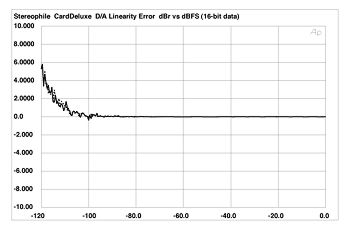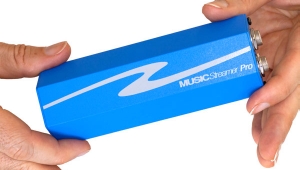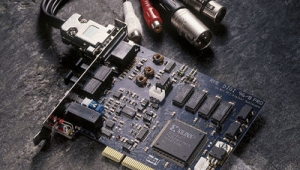| Columns Retired Columns & Blogs |
Digital Audio Labs CardDeluxe PC soundcard Measurements part 2
Fig.4 shows a 1/3-octave spectral analysis of the CardDeluxe's analog output while it decoded 16- and 24-bit WAV files representing a dithered 1kHz tone at -90dBFS. The increase in word length drops the noise floor by around 15dB, which implies excellent dynamic range—one of the better-performing DACs I have measured. There is a narrow 60Hz peak in the left channel's 16-bit trace, but as this is not present in the 24-bit trace, I assume this is atypical. Repeating the test with 16- and 24-bit "digital black" data revealed the presence of ultrasonic noise from the sigma-delta DAC's noiseshaping. However, the drop in the audioband noise floor with the 24-bit data was now almost 18dB, implying superb absolute performance around the 19-bit level.

Fig.4 Digital Audio Labs CardDeluxe, D/A 1/3-octave spectrum of dithered 1kHz tone at -90dBFS, with noise and spuriae, 16-bit (top) and 24-bit (bottom) data, 44.1kHz sampling (right channel dashed).
Linearity error (fig.5) was also very low: less than 1dB to well below -110dBFS. As a result of the low noise and superb linearity, the CardDeluxe's re-creation of an undithered 16-bit, 1kHz tone at -90.31dBFS (fig.6) is essentially perfect, clearly showing the three discrete voltage levels described by the digital data. Extending the data words to 24 bits gave a pretty good sinewave (not shown).

Fig.5 Digital Audio Labs CardDeluxe, D/A departure from linearity, 16-bit data (2dB/vertical div., right channel dashed).

Fig.6 Digital Audio Labs CardDeluxe, D/A waveform of undithered 1kHz sinewave at -90.31dBFS, 16-bit data.
- Log in or register to post comments

































